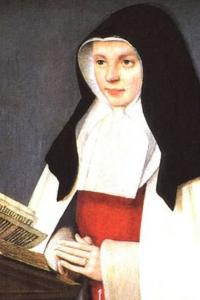
Feast day: 4 February
Joan was born in 1464 at Nogent le Roi in the county of Dreux, which is in the Loire region of France. She was the second daughter of Louis XI, often known as the "Universal Spider", who appears as a sinister character in the novels Quentin Durward by Walter Scott and The Hunchback of Notre Dame by Victor Hugo. Her mother was Charlotte of Savoy. Louis had no fondness for his daughter, as he had wanted a boy and she was also sickly and deformed, possibly with a curvature of the spine. Shortly after her birth Louis signed an agreement to marry her to his cousin, Louis, Duke of Orleans, later King Louis XII of France. As Louis was preoccupied with state affairs he entrusted his daughters Anne and Joan to the childless Baron Francois de Linieres and his wife Anne de Culan. The couple lavished affection on Joan; they taught her poetry, mathematics, painting, embroidery and music. They were also very pious. A friar, Jean de la Fontaine, was appointed her confessor, a role in which he served conscientiously. Joan devoted much of her time to prayer. She became a member of the Third Order of St Francis. In 1471, King Louis ordered that the Hail Mary should be recited throughout the kingdom for peace; Joan had a great love for this prayer, and she later wrote that she had received a prophecy from Mary that she would found a religious community in her honour.
In 1476 King Louis signed marriage contracts for his two daughters. Joan was married at the age of twelve to Louis, Duke of Orleans, who was fourteen years old. Louis had been forced to marry Joan and he was very unkind to her. She was supposedly sterile and the cynical king had hoped to extinguish the Orleans branch of the house of Valois. Louis died in 1483 and was succeeded by his son Charles who was still a boy. Duke Louis waged a campaign against the kingdom and was imprisoned. Joan administered his lands for him while he was held captive. He was later pardoned and took part in the Italian war with Charles VIII. Joan had campaigned for his release.
Louis became King in 1498 and he appealed to the Pope to have the marriage annulled. He claimed he had been below the age of consent at the age of fourteen and that the marriage had never been consummated. The lawsuit was described as "one of the seamiest lawsuits of the age." Louis' case was very weak and Joan would have won if justice had been served. However the Pope, the infamous Alexander VI (Borgia), annulled the marriage for political reasons. Joan was created Duchess of Berry and retired to Bourges, capital of the Duchy.
She confided to her spiritual director her call to monastic life. With his support she established the Order of the Annunciation of the Blessed Virgin Mary, an enclosed order and an independent branch of the Poor Clares. By 1500 she had received eleven postulants. The Rule of life she had written for the order was approved by Pope Alexander. The building of the first monastery began the following year. On Pentecost Sunday 1504 Joan and her spiritual advisor, Friar Gabriel Mary, made a commitment to follow the Rule and established themselves as co-founders of the order. In the same year on the feast of the Presentation of Mary, Joan and other women dedicated themselves to the order.
Joan died in 1505. and was buried in the chapel of the Annonciade monastery. Her grave was desecrated and her body, found to be incorrupt, was burnt by the Hugenots in 1562 during their sack of Bourges. Soon after her death miracles attributed to her were said to have occurred. She was beatified in 1742 and was canonized by Pope Pius XII in 1950. Her Order of the Annunciation of the Blessed Virgin Mary still exists in Europe despite vicissitudes during the Thirty years War and the French Revolution.
St Joan of France, pray for us.